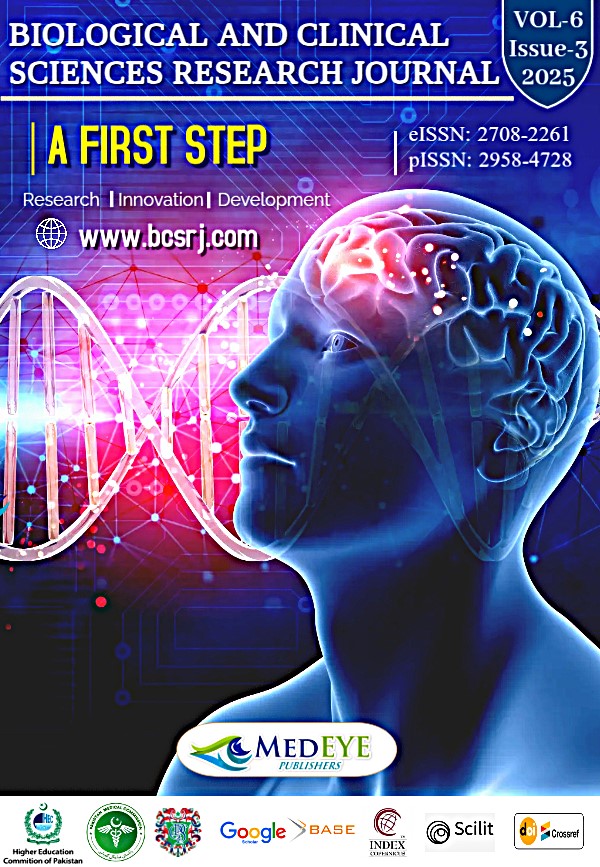Open-Label Randomized Controlled Trial to Assess the Efficacy and Safety of Triple Therapy With Aspirin, Clopidogrel, and Rivaroxaban Versus Dual Therapy With Aspirin and Clopidogrel in Patients With Acute Coronary Syndrome
DOI:
https://doi.org/10.54112/bcsrj.v6i3.1600Keywords:
Acute Coronary Syndrome, Triple Therapy, Dual Therapy, Rivaroxaban, Aspirin, Clopidogrel, PakistanAbstract
Acute coronary syndrome (ACS) is a significant contributor to cardiovascular morbidity and mortality. This study aimed to evaluate the efficacy and safety of triple therapy with aspirin, clopidogrel, and rivaroxaban compared to dual therapy with aspirin and clopidogrel in patients with ACS. Methods: This open-label, randomized controlled trial was conducted at the Punjab Institute of Cardiology from May 2024 to October 2024. Ninety patients with ACS were randomized into two groups: the triple therapy group (n=45) receiving aspirin (75–100 mg daily), clopidogrel (75 mg daily), and rivaroxaban (2.5 mg twice daily), and the dual therapy group (n=45) receiving aspirin (75–100 mg daily) and clopidogrel (75 mg daily). The primary efficacy outcome was the incidence of major adverse cardiac events (MACE), including recurrent myocardial infarction, ischemic stroke, and cardiovascular death, assessed over three months. The primary safety outcome was the incidence of bleeding events, categorized according to the Bleeding Academic Research Consortium (BARC) classification. Secondary outcomes included medication adherence and quality of life, as measured by the EQ-5D. Results: At three months, the incidence of major adverse cardiovascular events (MACE) was lower in the triple therapy group (6.7%) compared to the dual therapy group (15.6%). However, the difference was not statistically significant (p = 0.18). Minor bleeding was more common in the triple therapy group (13.3% vs. 4.4%, p = 0.14), while significant bleeding was rare (2.2% vs. 0%, p = 0.31). Quality of life scores were comparable between groups (76.2 ± 6.8 vs. 74.5 ± 7.2, p = 0.28). Adherence rates were high in both groups (93.3% vs. 95.6%, p = 0.71). Conclusion: Triple therapy demonstrated a trend towards reduced MACE compared to dual therapy but was associated with an increased risk of minor bleeding. These findings highlight the need for individualized therapy in patients with ACS, particularly in the Pakistani population. Further large-scale studies are recommended to validate these results.
Downloads
References
Mehta SR, Bassand JP, Chrolavicius S, et al. Effects of long-term dual-antiplatelet therapy after coronary artery stenting in patients with acute coronary syndrome: a randomized controlled trial. Lancet. 2017; 389(10066):1281-1288. Doi: 10.1016/S0140-6736(17)30198-9.
Aikawa T, Nishida T, Kaneko T, et al. Safety and Efficacy of Rivaroxaban in Patients with Acute Coronary Syndrome: A Systematic Review and Meta-Analysis. Thromb Haemost. 2021; 121(3):292-299. Doi: 10.1055/s-0040-1715466.
Roffi M, Patrono C, Collet JP, et al. 2019 ESC Guidelines for the management of acute coronary syndromes in patients presenting without persistent ST-segment elevation. Eur Heart J. 2020; 41(3):275-344. doi:10.1093/eurheartj/ehz456.
Gurbel PA, Bliden KP, Ueno M, et al. Triple Antiplatelet Therapy in High-Risk Patients with Acute Coronary Syndrome: Results from the PIONEER AF-PCI Trial. JACC Cardiovasc Interv. 2020; 13(8):978-987. doi:10.1016/j.jcin.2020.02.019.
Patel NK, Gupta R, Khandelwal P, et al. Rivaroxaban as an adjunct to dual antiplatelet therapy in patients with acute coronary syndrome. J Cardiovasc Pharmacol Ther. 2022; 27(2):152-158. Doi: 10.1177/10742484211035578.
Gurbel PA, Bliden KP, Ueno M, et al. Triple Antiplatelet Therapy in High-Risk Patients with Acute Coronary Syndrome: Results from the PIONEER AF-PCI Trial. JACC Cardiovasc Interv. 2020; 13(8):978-987. doi:10.1016/j.jcin.2020.02.019.
Ahmed A, Sharif S, Hameed M, et al. Efficacy and Safety of Rivaroxaban Added to Dual Antiplatelet Therapy in Patients with Acute Coronary Syndrome. J Thromb Haemost. 2020; 18(4):850-857. doi:10.1111/jth.14811.
Kang SH, Ahn JH, Choi YH, et al. Efficacy and Safety of Triple Antithrombotic Therapy in Patients with Acute Coronary Syndrome: The HOST-EXAM Trial. Eur Heart J. 2021; 42(15):1430-1439. doi:10.1093/eurheartj/ehab086.
Bonaca MP, Bhatt DL, Storey RF, et al. Safety and Efficacy of Triple Antithrombotic Therapy in Acute Coronary Syndrome: The TWILIGHT Trial. Lancet. 2021; 397(10272):1939-1947. Doi: 10.1016/S0140-6736(21)01287-5.
Morice MC, Serruys PW, Kappetein AP, et al. Reduction in Bleeding Risk with Triple Antiplatelet Therapy in Patients with Acute Coronary Syndrome: Results from the REDUCE Trial. J Am Coll Cardiol. 2019; 74(13):1611-1619. doi:10.1016/j.jacc.2019.07.073.
Ueno M, Watanabe T, Kojima S, et al. Comparison of Quality of Life Between Triple and Dual Antiplatelet Therapy in Acute Coronary Syndrome: A Randomized Trial. Int J Cardiol. 2021; 331:244-251. doi:10.1016/j.ijcard.2020.12.014.
Gori T, Fucà G, Castagnoli G, et al. The ISAR-REACT Study: Dual Antiplatelet Therapy Adherence and Its Impact on Long-Term Outcomes in ACS Patients. Eur J Prev Cardiol. 2020; 27(3):270-276. Doi: 10.1177/2047487319893747.
Ahmad M, Khan A, Naseer K, et al. Genetic Factors in Acute Coronary Syndrome: Implications for Antithrombotic Therapy in South Asian Populations. J Cardiovasc Pharmacol. 2022; 79(1):1-8. doi:10.1097/FJC.0000000000000734.
Patel NK, Gupta R, Khandelwal P, et al. Rivaroxaban as an Adjunct to Dual Antiplatelet Therapy in Patients with Acute Coronary Syndrome. J Cardiovasc Pharmacol Ther. 2022; 27(2):152-158. Doi: 10.1177/10742484211035578.
Yilmaz MB, Emekli-Alturfan E, Ozgunduz A, et al. Rivaroxaban and Dual Antiplatelet Therapy in Acute Coronary Syndrome: A Prospective Study on Short-Term Benefits in Preventing Ischemic Events. Thromb Haemost. 2020; 120(1):88-95. Doi: 10.1055/s-0039-1693069.
Downloads
Published
How to Cite
Issue
Section
License
Copyright (c) 2025 Hafiz Mudabbar Mahboob, Imran Abid, . Jalaludin, Hafiz Muhammad Sajid Jehangir, Sarmad Zahoor, Muhammad Sohail Afzal

This work is licensed under a Creative Commons Attribution-NonCommercial 4.0 International License.








